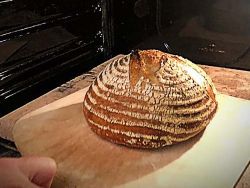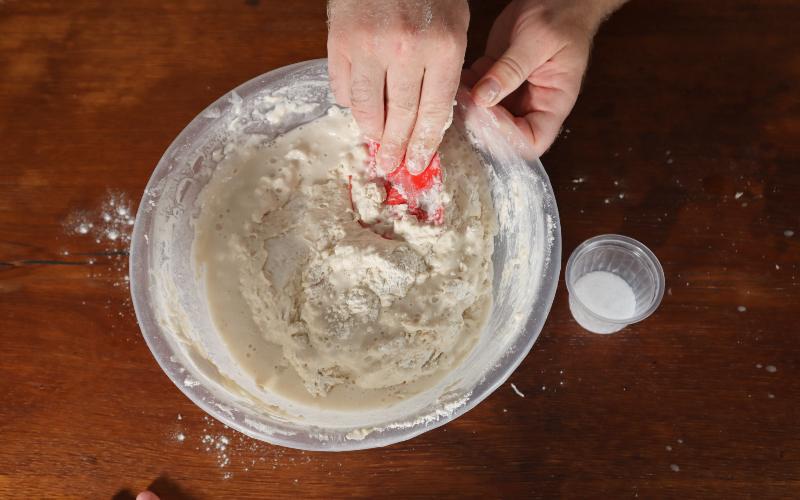
10 Tips To Improve Your Sourdough Bread Oven Spring

Getting a top-notch oven spring in your sourdough bread is the most rewarding moment of making bread at home. It sums all the previous stages to provide a result – it’s either a good oven spring or a bad one! If you’re here you’ll be looking to improve your sourdough bread’s oven spring so I’ll kick on with some tips so you can smile every time your bread comes out of the oven!
Sourdough oven spring explained:
When bread goes into the oven it rises an extra 20% (roughly) during the first 10-12 minutes. The rapid rise is called oven spring. It occurs in all leavened types of bread and is more aggressive when steam is introduced to the oven as it makes the process more effective.
Why sourdough bread rises in the oven
As the dough warms up, the yeast becomes more active and rapidly feeds on the available sugars. This creates a gush of alcoholic fermentation providing ethanol and carbon dioxide. The CO2 gas is retained in the gluten network and tiny pockets of air in the gluten expand making the bread rise.
Why oven spring ends
After 10-12 minutes the heat penetrates through the moisture to set the crust. The hardened outer perimeter halts the rise at the same time the temperature of the dough exceeds around 60C (140F) and yeast activity ends. After this point, the starch forms a rigid structure whilst moisture exits the bread.
How is the oven spring different in sourdough bread?
Sourdough is slower than yeast to produce gas. There is a lower concentration of yeast bacteria and more reliance on LAB to produce gas in sourdough bread. The fermentation of LAB is slower than yeast and therefore sourdough bread takes longer to rise than yeast-leavened bread. As the crust sets after 10-12 minutes in the oven, sourdough bread has less time to rise. The volume of the oven rise in sourdough bread will always be slightly less than the gains experienced in yeast-made bread. But, don’t worry! These tips will help you to balance this disadvantage out so you can produce sourdough bread with a great oven spring.
#1 Select the right flour

Using good quality flour is important if you want to make great-tasting bread. All brands of flour have different ratios of glutenin and gliadin gluten proteins. These change the dough’s ability to be elastic and stretch respectively. There will also be varying quality differences in the starch and protein particles which change how long the dough will need to bulk ferment. It’s worth selecting a few tried and trusted brands used by other home bakers in your area to experiment with.
White flour
White flour will give the best oven spring. Ideally, look for protein levels at 11-13%. Lower protein or all-purpose flour can be used to make quality sourdough bread, however, if you are struggling with your oven spring you will find a higher protein baker’s flour variety provides more reliable results.
Whole wheat flour
It’s harder to get a decent rise from sourdough bread made from 100% whole wheat flour. It needs a high level of experience in maturing and gluten and fermentation levels during bulk fermentation. If you want a more wholesome loaf it’s easier to start with a white sourdough bread recipe and switch out 10-30% of the white flour for wholemeal. Start with a low percentage of whole wheat and gradually build up as you gain confidence.
#2 Use an active starter

The starter you make your bread from needs to be nice and active. Weak starters don’t create enough activity in the dough to make the bread rise properly. You should be finding that your starter is tripling in size in around 6 hours. It can take several weeks under ideal conditions for a new starter to reach this point. If you need help to get an existing starter active, view my sourdough starter is not rising post.
#3 Autolyse

A sourdough autolyse won’t make or break the oven spring of your loaf, but it will increase the volume by around 5-10%. Taking this extra step means your flour is hydrated before bulk fermentation commences. This allows the gluten to unwind and stretch so it is ready to be kneaded and activates the protease enzyme which breaks down some of the glutenin strands to make the dough more extensible.
#4 Stretch the gluten
To build up the strength in the gluten you need to work or stretch it. This can be done with either kneading or stretch and folds. For the best rise in the oven, you need to develop the gluten well. Use the windowpane test to check your dough reaches 100% gluten development at the time of shaping.
#5 Bulk fermentation
A good bulk fermentation creates plenty of organic acids and ethanol in the dough. These are going to benefit the dough’s ability to create gas and retain it during the oven spring. To create the best environment for the bulk and second rise look at the sourdough fermentation article. It explains how important the levain and the temperature of the ingredients make a difference to your bake.
How to know when to end bulk fermentation?
At the end of the first sourdough fermentation stage, the dough should feel light and a bit gassy. The gluten should also be strong and pass the windowpane test.
#6 Good shaping
To create enough tension in the dough the shaping has to be done well. Yes, you can make sourdough bread by just chucking the dough in a proofing basket but for the best shape and oven spring, the dough has to be shaped correctly.
The method used is to degas most of the air from the dough and preshape. Leave for 20-30 minutes and then start the final shaping. The right shaping method is important to encourage the outer membrane of the dough to stretch. This helps it to strengthen and stretch in the oven also.
#7 Proofing
A lot of bread makers get this stage wrong. The bread should do the majority of its rising in the proofing basket (generally). The bread should rise to roughly full size before it’s baked.
After baking, most of the volume gained from the oven spring is lost as the bread cools and moisture evaporates and the bread contracts.
When is sourdough bread ready to bake?
To tell if the bread is ready for the oven you can use the poke test. Sourdough bread should stay down after it is poked for 2-3 seconds before springing back up. This is roughly double the bread’s original size.
#8 Cutting
For the best oven rise simple cutting is preferred to more intricate designs. You don’t want to let too much gas escape whilst you also don’t want to hold too much in as this makes the bread rip during the oven rise.
Do you cut wholemeal sourdough bread?
Wholemeal bread requires less cutting. A simple single slice is sufficient otherwise the oven spring is poor.
#9 Add steam to the oven
For oven spring to occur you need to add steam to the oven, It’s essential to the process. You can do this by simply baking the sourdough in a dutch oven or by using a water mister. After 20-25 minutes, open the door to release the steam – it really helps the quality of the bread. Here’s a detailed guide on adding steam to an oven.
#10 A properly heated oven
You should either bake in a dutch oven inside a preheated oven or in a preheated oven with a baking stone. You need the heat to be at 220-230C (430-450F) for the bread to bake through and crispen the crust.
This might require you to heat your oven an extra 10-20 degrees so it can cope with the heat loss when the bread is loaded.
Can you bake bread in a cold oven?
You can bake bread in a dutch oven without preheating the main oven either. It takes an extra 10-15 minutes and I’ve never been truly satisfied with my attempts. However, it saves a lot of money when it comes to utility costs so try it and see how it goes.

Conclusions
As you can see, a good oven rise is not just about the baking process. It’s about generating a quality dough that can retain and produce gas when it is baked as well. For a simple recipe, take a look at my sourdough bread recipe for beginners, if you follow each step closely I guarantee you will get a fantastic oven spring on your sourdough bread.
Sourdough oven spring frequently asked questions
If you’ve enjoyed this article and wish to treat me to a coffee, you can by following the link below – Thanks x

Hi, I’m Gareth Busby, a baking coach, senior baker and bread-baking fanatic! My aim is to use science, techniques and 15 years of baking experience to make you a better baker.
Table of Contents
- Sourdough oven spring explained:
- Why sourdough bread rises in the oven
- Why oven spring ends
- How is the oven spring different in sourdough bread?
- #1 Select the right flour
- #2 Use an active starter
- #3 Autolyse
- #4 Stretch the gluten
- #5 Bulk fermentation
- #6 Good shaping
- #7 Proofing
- #8 Cutting
- #9 Add steam to the oven
- #10 A properly heated oven
- Conclusions
- Sourdough oven spring frequently asked questions
Related Recipes
Related Articles
Latest Articles
Baking Categories
Disclaimer
Address
53 Greystone Avenue
Worthing
West Sussex
BN13 1LR
UK








Leave a Reply